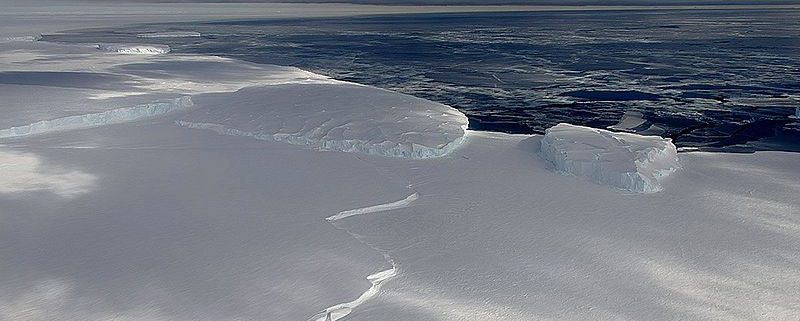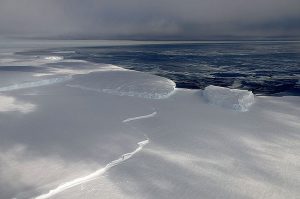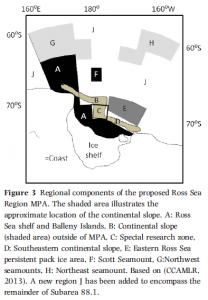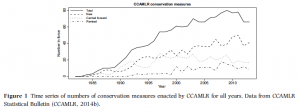Designation and management of large-scale MPAs drawing on the experiences of CCAMLR
By Julia Whidden, SRC Intern
While national governments have complete control over the resources in their exclusive economic zone (200 nautical miles from a country’s coastline), the “high seas”, or open ocean, belongs to no one. Resources are extracted from the high seas at an astonishing rate by nearly every country on our planet, and even though no one owns it, everyone benefits (at different rates). So how do you decide how to manage it?
Picture a group of kids in a room around a busted piñata, except it’s pitch black. No one knows exactly what they’re taking, or even what’s left. A parent sticks their head in the room to tell the kids to not eat all the candy at once, then leaves to let the kids act of their own accord. The parent can’t force the kids to take less, because the piñata isn’t theirs. This room is our oceans, each child is a country, and the parent is a bevy of international conservation treaties and organizations. In this paper, Designation and management of large-scale MPAs drawing on the experiences of CCAMLR by Everson (2015), the parents are the United Nations Convention on the Law of the Sea (UNCLOS), the Convention on Biodiversity (CBD), the World Summit on Sustainable Development (WSSD), and the Convention for the Conservation of Antarctic Marine Living Resources (CCAMLR) itself. These groups have provided frameworks and specific targets to improve the conservation of marine resources, but require relevant countries to take their own initiative to see that these goals are achieved.
CCAMLR is part of the Antarctic Treaty System (ATS), and is composed of a group of countries engaged in conserving the Antarctic environment and Southern Ocean. CCAMLR is a regional fisheries management organization (RFMO), established in 1982, that was the first RFMO to directly incorporate an ecosystem approach of conservation into its mandate. This ‘ecosystem approach’ was in essence an early definition of the now well-recognized ecosystem based fishery management concept (EBFM), which highlights the connectivity of ecosystems, and suggests that the most effective conservation measures will impact multiple levels of an ecosystem, as opposed to the traditional concept of conserving one particular species. CCAMLR also mandated a consensus approach to voting on “matters of substance”, meaning that all parties have to be in agreement on a matter. This ensures that minority countries are not be ignored by majority agendas – even when a majority agenda may be fighting for long awaited progress. CCAMLR approaches a topic first through Working Groups, where opposing views are discussed, which then lead to decisions on conservation measures (CM) being made at Commissions. Ideally, once at Commission, all parties have reached a consensus because disagreements were sorted and frustrations aired during the Working Groups. However, once consensus has been reached about a particular CM, minority views have the option to be included in Minority Reports, which may prove useful at subsequent meetings.
CMs are like a unit of measurement for RFMOs that indicate action taken and progress achieved. Cullis-Suzuki and Pauly (2010) consider CCAMLR’s number of CMs to be “impressive”, given the time they’ve been active, although CCAMLR suffered a notable failure in 2013 when Russia refused to join consensus in establishing what would have been the world’s largest ever marine protected area (MPA) in the Ross Sea, Antarctica, at 2.27 million km2. Russia, who coincidentally fish in the Ross Sea, voted against it due to questioning whether CCAMLR actually had legal authority to designate an MPA – which had previously been accomplished in the South Orkney Islands in 2009. Interestingly, Russia was one of 3 countries, including South Korea and Japan, that voted in approval of the South Orkney Islands 2009 MPA – but only if the MPA would have no impact on their commercial fishing in the area. Ie. Sure, we’ll help protect this area… as long our protection of the species within it does not conflict with my harvesting of species within it. In both cases, Russia managed to use the consensus method to achieve what was in their best interest, and in the case of the South Orkney Islands, it was at the loss of complete protection for the ecosystem. Everson reasons this loss actually relates more to the loose definition of an MPA than it does to the method by which it was voted for. In general, the odds of consensus being reached on conservation topics between parties with opposing views is unlikely, but Everson argues that the success of this method is increased by including all relevant parties from the very beginning stages of a matter, to promote dialogue and – hopefully – understanding. For CCAMLR, when a consensus still can’t be reached at Commission, matters are broken down to the key issues and progress is attempted at that level.
In the context of the kids with the busted piñata, this equates to agreeing to save enough Reese’s cups to last until tomorrow… but only if you’re not in charge of the black licorice.







Leave a Reply
Want to join the discussion?Feel free to contribute!